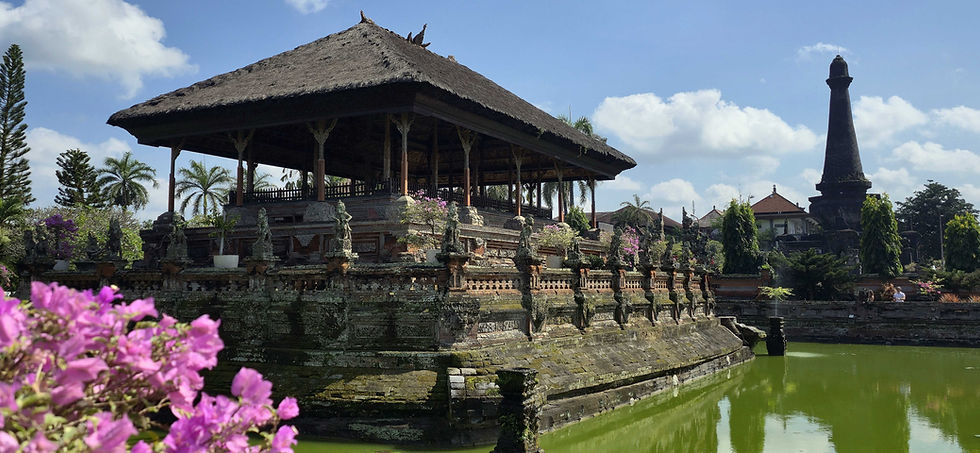Klungkung Royal Palace
- Shannon
- Sep 19
- 4 min read
The Rise and Fall of a Kingdom
Rising from the legacy of the Gelgel kingdom and the distant glory of the Majapahit Empire, Klungkung Palace was built in 1686 as the proud heart of a fractured Bali. For centuries it stood as a symbol of royal prestige, until 1908, when Dutch fire and a blood soaked puputan reduced its grandeur to ruin, leaving only whispers of power, betrayal and the ghosts of a kingdom that refused to kneel.

Officially known as Puri Agung Semarapura, the palace was once the political and cultural heart of Klungkung, tracing its lineage to the Gelgel kingdom of the 15th century. Though weakened by centuries of internal strife, it retained its prestige as the cultural heir of a unified Bali, until the Dutch conquest left most of it in ashes. Today, only the Kertha Gosa Pavilion, the main gate and the Floating Pavilion endure, their weathered stones and silent waters guarding the last fragments of a royal world lost to time.

The Bale Kambang or Floating Pavilion, is an open sided structure adjacent to the Kerta Gosa pavilion, surrounded by a moat that gives it the appearance of floating. Its ceiling is richly decorated with paintings arranged on six levels, illustrating Balinese astrological charts, folktales about ideal family life and the spiritual epic of Sutasoma (an ancient Javanese tale of a Buddhist prince). While its exact purpose is debated, ranging from a royal guard headquarters and reception area to a place for leisure and meditation, many agree it served multiple roles, including spiritual reflection. Architecturally, the pavilion symbolises Mount Meru, the cosmic centre of the universe, with the surrounding moat representing the cosmic ocean, linking the spiritual and earthly realms and emphasising the ancestral lineage’s power.

In the late 18th century, the Kerta Gosa Pavilion or Hall of Justice, was built in the palace complex, reflecting the local architectural and artistic style. As the highest court in Bali, unresolved cases from across the island were brought here, overseen by three priests and the King. While awaiting judgement, convicts could view the pavilion’s intricately painted ceiling, which vividly illustrated the consequences of karma and punishments in the afterlife. These ceiling paintings, created in a traditional style, are considered exceptional examples of local art, depicting stories of heaven and hell, moral tales and warnings about natural disasters. The artwork has been carefully maintained and restored over the years by skilled artists from the nearby village.

The puputan bloodbath and subsequent fall of Klungkung in 1908 was a tragic and dramatic final act of resistance against Dutch colonial forces. When Dutch troops launched a punitive expedition to Klungkung in response to rising tensions and earlier conflicts, the local Balinese royal family and their followers chose not to surrender. Instead, they engaged in a puputan, a ritual mass suicide and last stand where the royals, their retainers, women and children marched out from the palace to confront the invaders.

Armed mostly with traditional weapons, they faced the Dutch soldiers’ modern firearms. The confrontation quickly turned into a massacre. Those not killed by Dutch gunfire were killed by members of their own group to avoid capture, making the event not only a military defeat but a symbolic sacrifice embodying defiance and honour. The puputan marked the violent end of the Klungkung kingdom’s independence and led to the palace being largely razed and the royal family exiled.

The royal family returned in 1929 to settle in a newly built palace close to the original site, continuing their presence in the region despite the dramatic fall of their kingdom. Today, the rich history of Klungkung and the tragic puputan are thoughtfully commemorated through a dedicated local museum and a monument near the palace ruins. These serve not only as lasting reminders of the kingdom’s cultural and political significance but also as powerful symbols of resilience sacrifice and the enduring spirit of the Balinese people.

🗺️ Location
Jalan Diponegoro, Central Semarapura, Klungkung Regency, Bali, Indonesia
🚆 How to get there
Klungkung Royal Palace is located within the Kertha Gosa park complex and is easily accessible from major Balinese hubs. It's roughly 30 minutes from Sanur, 45 minutes to an hour from Ubud, and about 1 1/2 hours from Denpasar. Each route offers a scenic drive through rice fields and traditional villages, making the journey as enriching as the destination itself. You will likely pass this place on your way north or south, so have your driver stop in on the way.
⭐ Attraction Info
The palace is open daily from 8am to 5pm, with tickets sold at the official counter located beside the Puputan Monument on the opposite side of the road. Entry costs 50,000 IDR and includes access to the Bale Kambang and the Kerta Gosa Pavilion, as well as both onsite museums. Be cautious of self proclaimed tour guides who may approach you insisting you need to pay them directly, this is a common scam. The site is small and easy to navigate on your own, so a guide is not necessary. As with most sacred places in Bali, a sarong is required to cover your knees. I strongly recommend carrying your own to avoid dealing with aggressive vendors trying to sell or rent you one at nearly every historical site. Allow yourself 30 to 60 minutes to explore the complex and take in the surroundings at a relaxed pace.

Thanks for reading about the Klungkung Royal Palace. Check out more awesome destinations here!




































